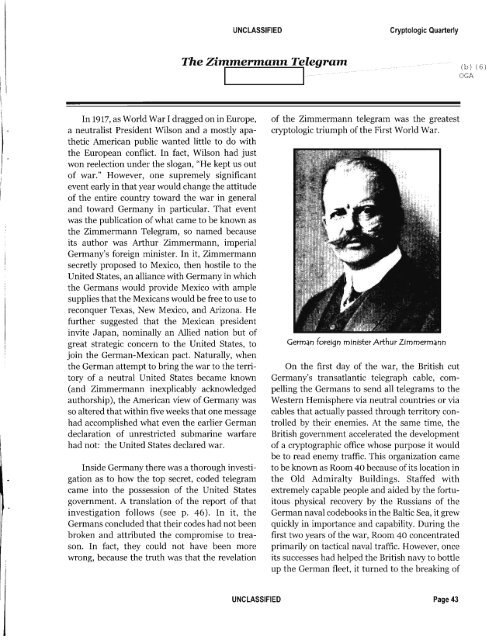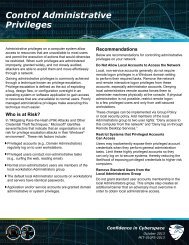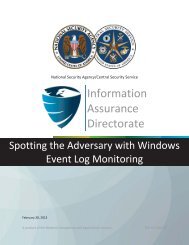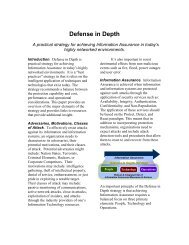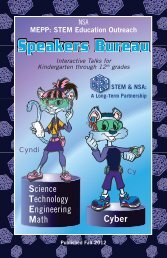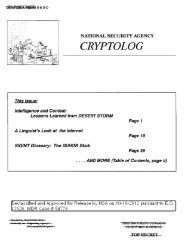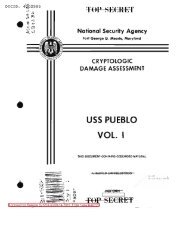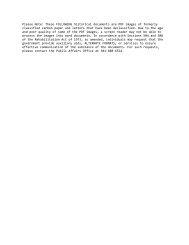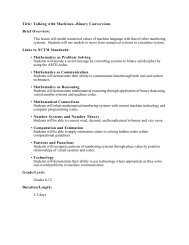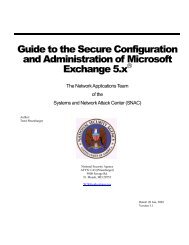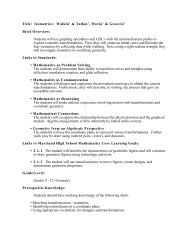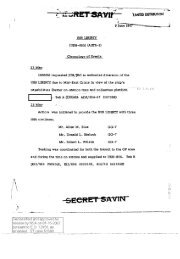The Zimmermann Telegram - National Security Agency
The Zimmermann Telegram - National Security Agency
The Zimmermann Telegram - National Security Agency
Create successful ePaper yourself
Turn your PDF publications into a flip-book with our unique Google optimized e-Paper software.
UNCLASSIFIED<br />
In 1917, as World War I dragged on in Europe,<br />
a neutralist President Wilson and a mostly apathetic<br />
American public wanted little to do with<br />
the European conflict. In fact, Wilson had just<br />
won reelection under the slogan, "He kept us out<br />
of war." However, one supremely significant<br />
event early in that year would change the attitude<br />
of the entire country toward the war in general<br />
and toward Germany in particular. That event<br />
was the publication of what came to be known as<br />
the <strong>Zimmermann</strong> <strong>Telegram</strong>, so named because<br />
its author was Arthur <strong>Zimmermann</strong>, imperial<br />
Germany's foreign minister. In it, <strong>Zimmermann</strong><br />
secretly proposed to Mexico, then hostile to the<br />
United States, an alliance with Germany in which<br />
the Germans would provide Mexico with ample<br />
supplies that the Mexicans would be free to use to<br />
reconquer Texas, New Mexico, and Arizona. He<br />
further suggested that the Mexican president<br />
invite Japan, nominally an Allied nation but of<br />
great strategic concern to the United States, to<br />
join the German-Mexican pact. Naturally, when<br />
the German attempt to bring the war to the territory<br />
of a neutral United States became known<br />
(and <strong>Zimmermann</strong> inexplicably acknowledged<br />
authorship), the American view of Germany was<br />
so altered that within five weeks that one message<br />
had accomplished what even the earlier German<br />
declaration of unrestricted submarine warfare<br />
had not: the United States declared war.<br />
Inside Germany there was a thorough investigation<br />
as to how the top secret, coded telegram<br />
came into the possession of the United States<br />
government. A translation of the report of that<br />
investigation follows (see p. 46). In it, the<br />
Germans concluded that their codes had not been<br />
broken and attributed the compromise to treason.<br />
In fact, they could not have been more<br />
wrong, because the truth was that the revelation<br />
<strong>The</strong> <strong>Zimmermann</strong> <strong>Telegram</strong><br />
I I<br />
Cryptologic Quarterly<br />
of the <strong>Zimmermann</strong> telegram was the greatest<br />
cryptologic triumph of the First World War.<br />
Germ,m foreign minister Arthur Zimmerm
It was immediately clear that the telegram<br />
was of inestimable value in finally drawing the<br />
United States into the war on the Allied side, a<br />
long-time British objective. Still, there were problems<br />
to be solved before the message could be<br />
shared with the United States government. First,<br />
Room 40 was one of the British government's<br />
darkest secrets. Its existence as the source of the<br />
compromise had to be concealed from the<br />
Germans. Likewise, the British needed to conceal<br />
from the Americans that they had been reading<br />
American traffic, a touchy issue in that the United<br />
States was a neutral country. Third, the telegram<br />
still contained a few gaps that might lead the<br />
Americans to question its authenticity or actual<br />
meaning. Hall hit upon an ingenious idea that<br />
addressed all three issues. Using a contact in the<br />
Mexico City telegraph office, he was able to obtain<br />
a copy of the enciphered message that had been<br />
forwarded from the German embassy in<br />
Washington. This version had been sent using<br />
code 13040, since the embassy in Mexico did not<br />
hold code 0075. As an older and less sophisticated<br />
code, the British had recovered most of it and<br />
were able to read virtually the entire text, allowing<br />
them to fill in remaining gaps. In addition, as<br />
a forwarded message, the telegram had been<br />
given a new date and header information by the<br />
Washington embassy. Use of this version would<br />
allow the British to convince the Americans that<br />
the message was obtained in Mexico and lead the<br />
Germans to suspect the same. Room 40's role<br />
would therefore be concealed.<br />
Because Germany had just declared unrestricted<br />
submarine warfare and the United States<br />
had broken off diplomatic relations as a result,<br />
Great Britain held the telegram for more than two<br />
weeks, hoping that it wouldn't be needed to prod<br />
the United States into war. However, when nothing<br />
happened, on February 22 the British delivered<br />
the <strong>Zimmermann</strong> note to American ambassador<br />
Walter Page, who greeted it with outrage.<br />
<strong>The</strong> British told him that they had no objection to<br />
its publication but requested that Great Britain<br />
not be revealed as the source. <strong>The</strong>y used the<br />
UNCLASSIFIED Cryptologic Quarterly<br />
Mexican cover story, which Page accepted, to<br />
explain their acquisition of the telegram, thus<br />
hiding their reading ofAmerican message traffic.<br />
Page telegraphed President Wilson with the news<br />
on February 24, setting in motion a chain of<br />
events in the United States that completely<br />
altered the nation's perception of German war<br />
intentions.<br />
As the British had requested, the United<br />
States government did not reveal the source of<br />
the telegram when it allowed the Associated Press<br />
to publish it three days later. In fact, a cover story<br />
was devised in which the United States claimed<br />
that it had obtained the telegram itself but could<br />
say no more out ofconcern for the lives ofthe persons<br />
involved. To support this story, the government<br />
retrieved from the Washington office of<br />
Western Union the coded original from<br />
Ambassador von Bernstorff to the German<br />
embassy in Mexico. This was sent to London<br />
where, using keys provided by Room 40, an official<br />
of the United States embassy deciphered the<br />
message. This allowed President Wilson to state<br />
truthfully that he had obtained the <strong>Zimmermann</strong><br />
telegram and its deciphered version from his own<br />
people, thus blunting the argument of many pacifists<br />
that the message was a fake supplied by<br />
Great Britain or France to inflame American<br />
opinion. <strong>The</strong> story was widely accepted in<br />
Congress and the country, and war was declared<br />
little more than a month later. However, as is evident<br />
from the following translation of the official<br />
German report that erroneously pointed the finger<br />
at an unknown traitor, the critical roles of<br />
Room 40 and cryptology in bringing about this<br />
momentous event remained secret.<br />
It is very probable that without the German<br />
foreign minister's message to the Mexicans, some<br />
other circumstance such as mounting American<br />
casualties and commercial losses as a result of<br />
unrestricted submarine warfare would have eventually<br />
drawn the United States into the war. <strong>The</strong>re<br />
can be no doubt, however, that this inevitability<br />
was hastened greatly by the deciphering of the<br />
UNCLASSIFIED Page 45
German messenger or agent, it was an easy task<br />
for the American State Department to decipher it<br />
with the help of the key placed at its disposal by<br />
the British government.<br />
<strong>The</strong>re are several conceivable ways in which<br />
the American government could have come to<br />
know of the Mexican dispatch. It could:<br />
1. have known the code 0075 that was used for<br />
transmission to Washington;<br />
2. have known the code 13040 with which the<br />
telegram was further forwarded to Mexico;<br />
3. have received the text itself through treason.<br />
1. <strong>The</strong> lottery cipher 0075 has been in use<br />
since the middle of July 1916 by the missions in<br />
Vienna, Sofia, Constantinople (these three with<br />
teletypes), Bucharest, Copenhagen, Stockholm,<br />
Bern, Lugano, the Hague, and Christiana, as well<br />
as at headquarters and the Reich chancellery. <strong>The</strong><br />
cipher with its secret key was sent to Washington<br />
in the cargo submarine Deutschland and reached<br />
there on November 3,1916.<br />
a. <strong>The</strong> assertion, also appearing in German<br />
newspapers, that the American embassy in<br />
Berlin was in possession of the cipher secrets is<br />
obviously false. Had the ambassador been able to<br />
read the text of the telegram, presumably he<br />
would not have forwarded it, but instead would<br />
have telegraphed the contents to Washington.<br />
However, as we know, he has not sent any<br />
telegram from Berlin that dealt with the contents<br />
of our telegrams. It is just as unlikely that in<br />
Washington one could have known the codes at<br />
the time the telegrams arrived, otherwise the<br />
telegram would not have been delivered to the<br />
embassy. We know besides that the Washington<br />
government was surprised by the announcement<br />
of submarine warfare on January 31. <strong>The</strong> contents<br />
of telegram no. 157, which gives the day for<br />
the commencement of submarine warfare, must<br />
Page 48<br />
UNCLASSIFIED<br />
therefore have been unknown to it up to that<br />
time. Otherwise, the American government<br />
would also have taken timely steps to prevent the<br />
disabling ofour ships.<br />
b. <strong>The</strong> possibility remains that the American<br />
government obtained the code later. In this<br />
regard the Stockholm Telegraph Bureau's report<br />
indicates that the American government possesses<br />
a document according to which the German<br />
government directed Count von Bernstorff on<br />
January 17 to take steps for the disabling of<br />
German ships. <strong>Telegram</strong> no. 157 dealing with the<br />
submarine war actually contains the concluding<br />
passage:<br />
UNCLASSIFIED<br />
Finally, I remind you of preparations<br />
for the thorough disabling of German<br />
steamers. You are responsible for seeing<br />
that the necessary word is passed<br />
at the proper moment by secure means<br />
so that no German steamer falls into<br />
foreign hands in a usable condition.<br />
In the Stockholm report the date is given<br />
incorrectly. <strong>The</strong> ciphered text of telegram no. 157<br />
contains the date January 16. Further, the question<br />
is raised whether the American government,<br />
if it knew that we made use of its ambassador as<br />
an intermediary for the transmission of the<br />
Mexican dispatch, wouldn't have exploited this<br />
against us in its parliament and with the public.<br />
Certainly it would be possible that it kept quiet<br />
about this because it wanted to keep from the<br />
Entente the fact that it transmitted telegrams for<br />
us whose contents it did not know. If the<br />
American government knew our code 0075, however,<br />
then the Mexican dispatch would have been<br />
made public with the date January 16, and not<br />
January 19. On the other hand, the report that<br />
Count Bernstorff simultaneously received<br />
instructions for the disabling of German ships<br />
does not offer sufficient support that the<br />
American government knows the code.
II. <strong>The</strong> embassy had the directive to forward<br />
to the mission the instructions intended for<br />
Mexico by secure means. Perhaps sending an<br />
official as a courier to Mexico could have been<br />
considered. However, this would have attracted<br />
attention. Also, the route oftravel was unsafe and<br />
slow; e.g., the trip by legation secretary von<br />
Schoen had lasted two weeks. Besides, the<br />
instructions were marked as "<strong>Telegram</strong> no. 1."<br />
<strong>The</strong>refore, there can be no objection that the<br />
embassy believed itself obligated to choose<br />
telegraphic means. <strong>The</strong>y provided for the communication<br />
with Mexico using three codes: no.<br />
5950, no. 13040, and in addition the Navy<br />
Communications Book with secret key. As everyone<br />
knows, code 5950 was compromised and was<br />
left in use for unclassified messages only. In order<br />
to make it usable again, at the behest of the Code<br />
Bureau of the Foreign Office, the embassy agreed<br />
upon a secret keying procedure with all posts in<br />
America that possessed this code, i.e., with the<br />
consulates in the United States and with the missions<br />
in Central and South America. For this<br />
arrangement code 13040 had been used. <strong>The</strong><br />
Code Bureau regards the procedure as good. <strong>The</strong><br />
mission in Havana, however, had given the<br />
embassy its opinion that even in this form code<br />
5950 would not be usable for confidential messages<br />
since the keying procedure was too transparent.<br />
It is the Navy's wish that the Navy<br />
Communications Book should be used for naval<br />
purposes only. Moreover, the embassy had<br />
received a telegraphic message from East Asia,<br />
according to which the Navy code was supposed<br />
to be compromised. On the other hand, it was not<br />
known to the embassy, either through its own<br />
experience or through communications from<br />
Berlin or other posts, that code 13040 was to be<br />
considered compromised. <strong>The</strong>refore, the<br />
embassy could envision sufficient security for<br />
secure transmission with the use of this code.<br />
Certainly it could have increased security by converting<br />
the ciphered digits using the Navy secret<br />
key whose confidentiality had not been lost by the<br />
compromise of the Communications Book.<br />
Nevertheless, no rebuke can be directed at the<br />
UNCLASSIFIED Cryptologic Quarterly<br />
embassy for the omission of this security measure,<br />
since the Foreign Office also used code 13040<br />
without secret key for the encryption of the<br />
instructions going to Mexico when it was the<br />
intention to send them via cargo submarine to<br />
America and to send them from Washington telegraphically<br />
to their destination.<br />
At the embassy in Washington there was a<br />
directive to convert all ciphered telegrams to<br />
Mexico and within the United States to words<br />
using the ABC Code and to send them to the telegraph<br />
office. This was done for reasons of economy,<br />
since otherwise not every group but every<br />
digit would count as a word for purposes of payment.<br />
However, the conversion also had a certain<br />
significance for code security in that it was not<br />
immediately apparent that one was dealing with<br />
an enciphered telegram. According to telegram<br />
no. 13 from Mexico A.S. 1226 the conversion of<br />
the telegram of January 19 doesn't seem to have<br />
been done. Embassy staffer Kunkel, who personally<br />
worked on the encryption, "believes" he<br />
remembers that it left Washington in digits plus<br />
ABC Code. It arrived in Mexico in digits only. It is<br />
improbable that a re-conversion should have<br />
taken place at one of the telegraph offices. That<br />
could only be done for the purpose of deciphering,<br />
and then the perpetrator would certainly<br />
have been too careful to expose his attempts in<br />
such a clumsy way. It is more probable that<br />
Kunkel is mistaken.<br />
Code 13040 had been in use since 1912 in<br />
Washington and New York, Havana, Port au<br />
Prince, and La Paz, and since 1907-1909 in the<br />
other missions in South and Central America. In<br />
the case ofa lot of enciphered material the meaning<br />
of a more or less large part of the code can be<br />
deduced. It is, however, improbable that the<br />
American government should have succeeded in<br />
deciphering the telegram on the basis of code<br />
materials known to it or provided to it by the<br />
English secret service. Also speaking against such<br />
an assumption is the fact that the text made public<br />
by the American government is without gaps,<br />
UNCLASSIFIED Page 49
especially that the names Arizona (four groups)<br />
and Texas (two groups) are reconstituted in it.<br />
<strong>The</strong> American government could, however,<br />
have come into possession of the code itself or<br />
obtained a copy or photo of it. This could have<br />
happened at any place where the code is found. A<br />
misappropriation of the code has not been<br />
reported by any of these places. <strong>The</strong> consulate in<br />
Guyamas in Mexico, where a break-in is supposed<br />
to have occurred, did not possess the code.<br />
In Washington and New York all codes were<br />
burned under supervision after diplomatic relations<br />
were broken. Indications of forcible entry<br />
into the workspaces or forcible attempts to open<br />
the code cabinet have never been noted either at<br />
the embassy or at the general consulate.<br />
Nevertheless, safeguarding of the codes in<br />
Washington was not especially secure; they were<br />
located in an older cabinet that was locked only<br />
with a combination lock that was already somewhat<br />
worn out. <strong>The</strong> combination had not been<br />
changed since 1902. When a combination lock is<br />
well worn, even a nonspecialist, if he's lucky, can<br />
correctly dial the combination by feel. It also<br />
wouldn't have been difficult in the summer, when<br />
the embassy was in the countryside and only very<br />
few personnel remained behind in Washington,<br />
to slip into the chancery spaces, remove code<br />
13040 from the code cabinet, photograph it, and<br />
put it back again. Code 13040 was located in<br />
Washington during the summer in 1915 and 1916.<br />
In addition, one must consider that one ofthe<br />
officials could have betrayed the code. At the<br />
embassy 12 mid-level officials had access to the<br />
codes in addition to court councilor Sachse's son,<br />
who worked as an assistant clerk for a year and a<br />
halfuntil the fall of1916. Should one ofthese people<br />
have betrayed the code, it would be striking<br />
that this code, and not also the lottery codes,<br />
especially code 0075, was chosen. However, as<br />
elaborated above, it should not be assumed that<br />
the American government possesses code 0075;<br />
also, there is no basis for believing that the other<br />
codes, in which many telegrams and mail codes of<br />
UNCLASSIFIED<br />
Page 50 UNCLASSIFIED<br />
great interest to the American government were<br />
sent, are known to the American government.<br />
At the general consulate in New York, where<br />
the codes were safeguarded under triple lock, the<br />
circle of persons who had access to the codes was<br />
smaller. Besides the consulate administrator, this<br />
consisted of the three vice consuls and consulate<br />
secretary Bern. Consulate secretary Georges, who<br />
was originally supposed to return to Germany,<br />
then however remained behind \vithout authorization,<br />
was never involved in code work. It can be<br />
considered out of the question that he should<br />
have come into possession of code 13040.<br />
Finally, it is definitely improbable that the<br />
American government possesses code 13040, for<br />
then the text of the Mexico dispatch would certainly<br />
have been made public with the serial<br />
number and notations "decipher yourself' and<br />
"acknowledge receipt," as well as with the serial<br />
number of the Washington embassy and the signature<br />
of Count Bernstorff, because in so doing<br />
its genuineness would have been made even more<br />
believable from the very beginning. Further, it<br />
should be borne in mind that code 13040 has<br />
been used for many secret messages, among them<br />
for an exchange oftelegrams between Mexico and<br />
New York regarding the delivery ofequipment for<br />
the wireless receiving station in Mexico. It can be<br />
assumed that if the American government knew<br />
of these telegrams, they would have now made<br />
them public.<br />
III. It is more probable that the text of the<br />
Mexico dispatch was betrayed.<br />
a. <strong>The</strong> Imperial envoy in Mexico considers it<br />
out of the question that the dispatch should have<br />
become known through treason or indiscretion in<br />
Mexico. Speaking against this possibility is especially<br />
the fact that telegram no. 11 to Mexico,<br />
which directs the immediate implementation of<br />
the instructions in the event of war given in<br />
telegram no. 1 and accordingly was of particularly<br />
great interest to our opponents, has not
ecome known. Both telegrams were deciphered by<br />
a legation secretary and were not read by chancery<br />
officials. <strong>The</strong> original ciphered texts were burned<br />
immediately by the legation secretary and the ashes<br />
were scattered. Until they were ordered burned, the<br />
deciphered versions ofboth telegrams were secured<br />
in a new steel safe in legation secretary Magnus's<br />
bedroom which is located in the chancery building.<br />
b. In Washington, six or seven officials had<br />
worked on the deciphering oftelegram nos. 157 and<br />
158. Afterward, the embassy councilor had directed<br />
that talking about them, even within the chancery,<br />
would not be permitted. However, all mid-level<br />
officials with perhaps the exception of court councilor<br />
Sachse, who was sick, and embassy staffer<br />
Kiihn, knew of the Mexico dispatch; one of them<br />
read through the deciphered document once again<br />
a week later. <strong>The</strong> deciphered document - a carbon<br />
copy doesn't seem to have been made - was filed<br />
unsealed in the same file as, and in fact directly<br />
behind, the telegram no. 157 that contained the<br />
concluding passage about the disabling of German<br />
ships. <strong>The</strong> filing cabinet in which this file was<br />
secured was accessible to all middle-level officials<br />
ofthe embassy, i.e., 12 persons. <strong>The</strong> deciphered version<br />
of the Mexico dispatch was destroyed in the<br />
first few days of February, apparently on February<br />
1. In the time from January 19 to February 1 it can<br />
be established that each of these officials, with the<br />
exception of court councilor Sachse, Dr. Edler, and<br />
Seibert, were alone and unobserved in the chancery<br />
for a long period of time. At any rate, this was the<br />
case during midday duty" perhaps evening duty as<br />
well. Each of them could therefore have copied the<br />
dispatch. <strong>The</strong> perpetrator would then have either<br />
sold the copy or a translation to a foreign agent or,<br />
without negative intentions, have given it to an<br />
acquaintance who for his own part betrayed it. <strong>The</strong><br />
dispatch is also so short that someone with a good<br />
memory can certainly remember the text after one<br />
reading. <strong>The</strong> perpetrator could have communicated<br />
the final section of telegram no. 157 at the same<br />
time. In so doing he would have erroneously given<br />
the date as January 17. This date was of no special<br />
interest, while the date of the Mexico dispatch was<br />
UNCLASSIFIEDflFOR OP'l"leiAL l:JSE eNb-Y Cryptologic Quarterly<br />
significant in order to be able to verify the message<br />
through comparison with the enciphered telegram<br />
that had been sent.<br />
<strong>The</strong> American side asserts that the government<br />
already possessed the text at the time that diplomatic<br />
relations were broken. It is not very likely<br />
that it should have quietly held onto it for so long.<br />
One would sooner be inclined to believe that the<br />
State Department would have made it public<br />
immediately after receiving it. <strong>The</strong>n one would<br />
come to the view that one of the officials who<br />
remained behind in America is the perpetrator, or<br />
that if the perpetrator was among the departing<br />
officials, he would have left negotiations with the<br />
American or English agent to an accomplice, with<br />
instructions to sell the dispatch only after a certain<br />
amount of time had elapsed. It would certainly also<br />
be possible that the treason took place earlier and<br />
to deflect suspicion, a delay in making the document<br />
public was a condition of the betrayal. Of<br />
course the State Department would have violated<br />
this agreement when it let it be known that it was<br />
already in possession of the dispatch at the time<br />
that diplomatic relations were broken. Supporting<br />
the idea that treason is involved is Lansing's declaration<br />
in the Senate that he could not make more<br />
detailed statements about the acquisition ofthe dispatch<br />
without endangering the lives of certain persons.<br />
That doesn't have to mean someone who is in<br />
Germany or on the way there. It is just as likely that<br />
Lansing had in mind that German retaliation 'could<br />
also strike the perpetrator in America.<br />
It should be clearly emphasized that for all officials<br />
on whom suspicion could fall from this point<br />
on, the best evidence is given by their superiors as<br />
well as that officials who have been interviewed<br />
declare it to be out of the question that one of their<br />
colleagues could have committed such an act.<br />
/signature/<br />
UNCLASSIFIEDor6R 6rrieiAL l:JSE 6NLY Page 51


